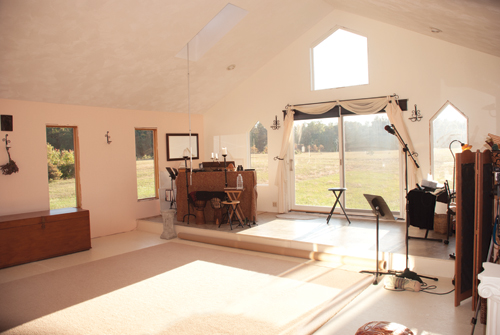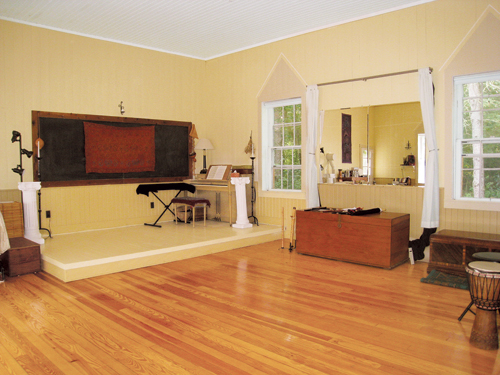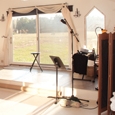
In conversations over the years with others, I have discovered that I am a bit unusual when it comes to my practice space. I do not like to practice around listening ears. Not so with performing, which I eagerly live to do, and I have no problem rehearsing in public. However, the solo work of dismantling and rebuilding with constant repetition that is my practice method seems an intensely private affair to me, and I marvel at those who can unselfconsciously practice no matter the proximity of any other hearers. This struggle has led me to find special places in which to practice.
Of course, I have often been forced to practice in places where others can hear, such as hotel rooms, or in our small Italian village where the entire town can hear the flute wafting through the narrow streets. They don’t mind hearing me practice, but I do. To avoid being heard, I trek off into the mountains that surround the town, and practice freely at an ancient, forgotten hermitage. My wish to spare others hearing me practice is more than mere politeness. I simply do not work as effectively when I know I am being heard; I lack the impetus to experiment, which is an essential part of the training process. Instead I simply play through pieces of music for the unseen listeners, and it becomes a day off from real work.
I suspect my problem toward public practicing came about shortly after starting the flute at age ten. I had studied the piano for three years and loved that my teacher was my grandmother who lived just over the hill from our Montana house, but I disliked that I had to practice publicly because of the location of the piano. You could not carry it out to the woods or to another room. Though our piano was down in the basement, it was still heard by the entire household, and I found myself always aware of this fact and felt less free to try new things. More than that, this public practice inevitably invited parental comments and suggestions, which were never received as willingly as offered. I discovered that I needed to be free of being critiqued while practicing, whether internal or external, real or imagined. Practicing in its fullest means keen analyzing, not the stifling critic.
The day finally arrived in 5th grade when I got that beautiful flute in my hands. I was adamant that I would find a place where I could learn to play without being heard. It turned out that the only place I could find was in my bedroom closet. An entire wall of my bedroom was closet space with four large metal bi-fold doors. The depth of the closet was only about 2.5 feet, but there was plenty of length to establish a private work area. I have the happiest memories of this space; it was perfect with a chair that allowed me to sit facing the sliding doors, flute lengthwise in the space. I put in a light, books, and everything I might want while practicing. Best of all, the closet muffled the sound, and I was free to work without outside observation. It did tend to get a bit hot in there, and I periodically had to open the door for fresh oxygen, but it was a superb place to practice, where I could diligently work in solitude.
When everyone in the house happened to be gone, my favorite place to practice was right in the middle of our living room, looking out an enormous picture window at the stunning Montana mountain range. I also thoroughly enjoyed hiking to the top of a ridge behind the house and from this great height playing music into the vastness of mountains and sky, as far as the eye could see. I believe it is just such experiences that teach us musical depth.
When I went off to the university, I had a perfect practice room on the top floor of a large building. In a previous incarnation it had been a woman’s dormitory but was now converted for use as ideal practice rooms. The rooms had high ceilings, most had upright pianos and some included carpet remnants – and all produced varied acoustics.
It was here that I learned how vital it was to have a practice space with helpful acoustics. A slightly reverberant space is always inspirational, as opposed to my previous heavy-carpeted and cloth-filled closet acoustic. In this new practice building, I took advantage of the variety of rooms. Sometimes I would go to a very live, reverberant room to see if a fast-tongued piece was still clear in all the swim of sound. Other times I would go to the driest room possible, to see if I could still make the slow melodies sing. I had a private room in this building with its own key, where I could keep a tape recorder, metronome, and lots of sheet music. For added inspiration, I hung pictures of Mikhail Baryshnikov dancing to remind me of the way I wanted to play the flute. A Carnegie Hall poster with the view from the stage out to the audience reminded me where I wanted to go. The room had a little carpet, a mirror I found somewhere else in the building, and a nice southwestern blanket on the ceiling to make the acoustics better. It was my permanent practice space all five years of university.
Since this building was only for fellow practicers, I did not consider it public practicing. It felt private. It also helped that I was on the outside wall, top floor, farthest from all other rooms, and I came to practice every day at 7 a.m. The only other person that had that same hour of practice was a clarinet player, who evidently had the same need for privacy.
One year I worked part-time to continue putting myself through school and adopted a crazy practice schedule. I came in the dark from 2 a.m. to 7 a.m., and finished up by swimming laps at the school pool. I headed home to go to bed when everyone else was just getting started with their day. For those 2 a.m. practices, I played in an internal room, so the fraternity house next door would not hear me. I also never turned on the lights, so I became good at memorization and inventing exercises that did not require reading music.
I was the only one in this large, old, three-floor building, and I often heard creaking noises down the halls when I stopped playing. This always scared me into a cold sweat, so I learned to keep playing with as few breaks as possible, until daylight began to dawn. It worked, and no ghost ever opened my practice room door!
After university I faced new practice challenges during tours around the world. Little time is available for real practice on the road, so I have learned to be satisfied with stage rear, green rooms, bathrooms, and stairwells. When I was back home, I found a variety of practice spaces: a high-ceilinged, heated tack room located in a beautiful old barn; early mornings in a boathouse on a misty pond; a room in the maids quarters of an old New England house; a perfect cabin that had no electricity or plumbing (but had a wood stove); and finally, a stunning country church that I had all to myself except for Sunday mornings. This church was an ideal practice space, with its live acoustics and large size that taught me how to really play out. I still practice in this church whenever I am in New England. I realized again that these varied practice spaces taught me as much as the work itself.
From this church practice domain, I moved to Michigan where my husband built me my own practice building. (See picture at top) It looked like a smaller version of the church I had just left, with plenty of windows and wonderful acoustics. It was perched out in a meadow teaming with wild-life and blueberry bushes. I enjoyed that place for eight years, until moving again two years ago. I am happy to say that the place where we now reside has an authentic 1878 one-room schoolhouse, moved to the property years before our time (below). This is the wonderful practice space in which I now thrive. I love the daily reminder of its purpose; it was a place for learning long before I was ever born.

To enter a separate space that is designated solely as a work space is an inestimable gift that allows me to keep focused on the work. There are far too many distractions when I play at home. The phone rings, laundry beckons, company visits, and there is always another chore to do rather than practicing. When I come to my schoolhouse each day, I dress up for work, including performance shoes. This is how I train for what I do, and it helps me focus better on the tasks at hand.
I encourage everyone to find a special place that is free from distractions, where you can start simply with just your flute and some music. Don’t be afraid to ask a local church if you can practice there. Another option is a small concert hall, stage, or high school auditorium during the times of day when it is not in use. I have found that the world is full of conducive work spaces; each one offering different lessons for you to expand your playing abilities and musicality. May you find your perfect space, and thoroughly enjoy the journey while searching for it.






